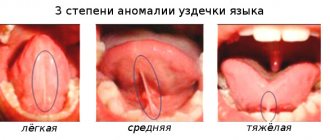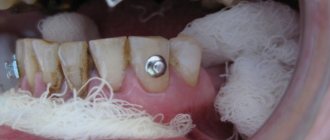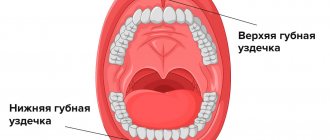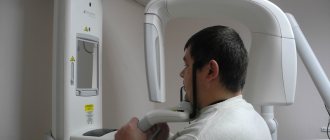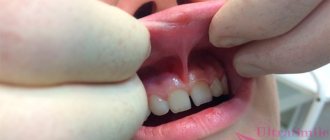Quick transition Treatment of a short frenulum of the tongue
A short frenulum of the tongue (ankyloglossia) is one of the most common minor anomalies in the development of the oral cavity.
The frenulum of the tongue is a fold of the oral mucosa that runs along the midline and connects the floor of the mouth with the lower surface of the tongue.
The function of the tongue frenulum is to fix the tongue to the soft tissues of the oral cavity, preventing tongue retraction (glossoptosis), especially during the neonatal period.
Symptoms
When crying, the tip of the baby's tongue bifurcates in the shape of a stylized heart.
The baby cannot stick his tongue out of his mouth. To test this reflex, you can run your finger over the baby's lips. Normally, the baby sticks his tongue out quite far, moving it around his lips in search of mother's milk.
Breastfeeding takes a lot of time, the baby is capricious, nervous, and clicking sounds are heard when sucking.
The baby is not gaining weight well.
A child with a short frenulum cannot reach the palate with his tongue.
There is a noticeable disturbance in the pronunciation of certain sounds during speech formation.
With a short frenulum (less than 1.5 cm), if it is attached to the soft tissues of the floor of the mouth, functional disorders do not always occur. These include difficulty sucking during breastfeeding and disturbances in sound pronunciation during the formation of phrasal speech.
When to perform the operation?
It is best to perform the operation on children aged 5 to 8 years during the period when baby teeth are replaced by permanent teeth. The most appropriate moment is when the lateral incisors (“twos”) have not yet erupted, and the central ones have appeared by about a third. Plastic surgery will prevent the development of diastema and will help the incisors to take a central place.
The operation can be performed on both adolescents and adults. Plastic surgery of the frenulum of the upper lip in infants is performed only according to strict indications that affect the quality of the child’s nutrition.
In adulthood, surgery most likely will not solve the problem, but it will greatly facilitate the process of prosthetics.
Consequences of frenulum anomaly
Hypotrophy due to impaired sucking, poor weight gain in infants.
Malocclusion, the first signs of which during the period of temporary occlusion is the rotation of the central lower incisors to the lingual side.
Impaired development of the lower jaw, as a result, the formation of a distal bite.
Local gingivitis, periodontitis up to exposure of the roots of the teeth in the area of the lower jaw incisors.
Violation of the pronunciation of sounds that require raising the tongue upward: “sh”, “zh”, “sch”.
Impaired language development due to asymmetrical growth. Low mobility of the tongue impairs the articulation of some sounds. Violation of diction (clarity, intelligibility of pronunciation).
How is the operation performed?
During a frenuloplasty operation, depending on the type of its structure, the surgeon cuts the fold, excises excess tissue or moves the point of its attachment to the gum. The procedure is performed under local anesthesia, is absolutely painless and lasts no more than 10-15 minutes.
At the IONIKA clinic, doctors are equally proficient in both methods of frenuloplasty - laser and scalpel. Each technique has its own strict indications, its advantages and disadvantages. Despite the fact that laser plastic surgery of the upper lip frenulum has gained the greatest popularity today, we sensibly assess each clinical situation and choose the optimal way to solve the problem based on the patient’s characteristics.
- Laser . This is a minimally invasive method in which a laser beam “dissolves” the frenulum or removes excess tissue, immediately sealing the edges of the wound. The operation is completely bloodless, without the need for stitches, and rehabilitation takes a minimum of time. Laser plastic surgery of the lower lip frenulum is most often used when working with young patients.
- With a scalpel . The classical method is also low-traumatic and is supplemented only by suturing. It is used, as a rule, in cases with a thickened frenulum.
How long will it take to heal?
After plastic surgery of the frenulum of the lower lip, the rehabilitation period takes up to two weeks, and the wound on the upper lip heals in just a few days. In the first case, anti-inflammatory treatment is often prescribed to ease the postoperative period and eliminate the risks of complications.
To avoid injury and the risk of infection, thorough but gentle oral hygiene twice a day is necessary. You should avoid hard and hot foods in your diet, and rinse your mouth after eating. Parents are advised to pay closer attention to the cleanliness of their child’s hands.
Return to list of articles
Causes of the defect
The anomaly occurs during intrauterine development. The provoking factors of a short frenulum of the tongue are:
- fetal infection;
- viral diseases that occur during the first and last trimester of pregnancy;
- genetic predisposition, heredity;
- unfavorable environmental background;
- abdominal injuries of a pregnant woman;
- chronic somatic diseases of the expectant mother.
The decisive factor is heredity. It was noted that among parents who personally encountered a similar pathology, their children often also needed frenulum correction.
How to recognize pathology in a child
A neonatologist, pediatrician, or the mother herself can recognize a pathological frenulum of the tongue in a newborn. If during the first and subsequent breastfeedings the baby experiences difficulties and cannot grasp the nipple correctly, then there is a reason to consult a doctor.
The second common sign of a pathological frenulum of the tongue in children is the occurrence of a speech defect when they begin to speak in phrases, namely at 3-4 years. Most often, with this anomaly, children do not pronounce several letters: “zh”, “sh”, “sch”, “ch”, “z”, “l” and “r”. Moreover, the sound “l” is easily pronounced if it is followed by a soft vowel, for example, “i”, “yu”, “e”, “e”, “ya”, in other cases it is simply “swallowed”. If there is incorrect pronunciation of sounds, then an examination by a speech therapist is necessary.
The most common symptoms of a tongue tie in a child are the following:
- the child is not able to reach the front teeth of the upper jaw or palate with the tip of his tongue;
- the child may have difficulty moving the tip of the tongue from one side to the other;
- the front teeth of the lower jaw may have a gap between each other;
- when the tongue is pulled forward, its tip remains flat, square or heart-shaped (that is, the front edge of the tongue seems to bifurcate);
- feeding problems in newborns.
It is important to understand that if the problem of the tongue frenulum exists, then sooner or later it will have to be solved. The sooner measures are taken, the easier and more painlessly the baby will endure them.
Frenuloplasty
Frenuloplasty is a surgical method for treating the complete form of ankyloglossia. It is performed on children who are already 5 years old, since they are already able to understand the essence of the procedure, as well as on adult patients. There are 3 options for performing the operation:
- Removal - during the operation, a significant part of the frenulum is clamped with instruments, incisions are made from below and above in the shape of a triangle, and the edges of the wound are sutured.
- Cutting is the easiest method for this pathology. The fold is cut, and its side edges are pulled together using transverse seams, while grasping the fabric at great depth.
- Moving the attachment point. In this case, 2 incisions are first made, which separate a strip of tissue between the interdental papillae and the transitional fold. The edges are brought together using suture material, and the cut strip is then sewn to the area of the wound that remains.
Exercise is a good alternative to surgery
If parents are willing to put in a lot of effort and spend a lot of time, then treatment for a short frenulum of the tongue can be carried out using gymnastics. Classes with the child should be regular, several times a day, and the number of approaches and repetitions should be gradually increased.
Basic exercises to stretch the frenulum:
- tongue movements with half-opened lips along the upper lip;
- protruding the tongue to its maximum length and returning it back;
- licking a saucer (or imitating this action);
- touch the tip of your nose with your tongue, then your chin and your nose again.
After treatment for a short frenulum, the patient visits a speech therapist and gets acquainted with special exercises that help stretch the muscles and folds of the tongue. In some cases, facial massage is performed. If angiloglossia is treated in a timely manner, there will be no consequences for the full development and health of the child.
Contraindications for surgery
There are practically no contraindications for laser excision of the labial frenulum compared to other operations. The procedure can be performed even on children as young as 6 years old.
Parents should know that laser lip frenuloplasty is the least traumatic and uncomplicated operation that can solve many problems that a child may encounter in adulthood.
Despite this, there are a small number of contraindications, including: - The patient has cancer; — Severe mental and neurological diseases; — Serious defects in the structure of the oral cavity; — Blood diseases; — Infectious diseases in the acute stage; — Advanced caries; - Osteomelit.
As you can see, contraindications are quite serious diseases that are rare. But it should be remembered that a referral for this operation, like any other, can only be given by a qualified dentist after an in-person consultation with the patient.
Indications for surgery
You should know that not every pathology of the labial frenulum requires mandatory surgery. The advisability of excision of the frenulum is usually determined by the orthodontist or periodontist during an external examination of the patient.
The operation is indicated in the following cases: - For orthodontic treatment. Pathology of the frenulum can prevent the normal installation of dentures (plates and braces). - Presence of a diastema (gap between teeth). The gap between your front teeth can widen and lead to gum disease such as periodontitis. — Periodontal diseases. Due to the incorrect structure of the frenulum, food can accumulate under the lip, which gradually rots, thereby creating favorable conditions for the development of dental diseases. - Problems with speech. Severe pathology can sometimes cause impaired diction.
Exercises for correcting the frenulum of the tongue and in the postoperative period
Postoperative frenulum stretching and correction exercises are aimed at developing new muscle movements of the tip of the tongue inside and outside the mouth. Regular practice will increase the range of movement of the tongue.
Articulation exercises by themselves will not improve speech and will not be able to correct the defect, so it is very important to carry them out in conjunction with individual speech therapy sessions.
The most common and universal exercises for stretching and correcting the frenulum of the tongue are given here in the article. Following them, you can study at home with your child on your own:
- Stretch your tongue forward, then stretch the tip up to your nose, then down to your chin. Relax, repeat the exercise several times (at first, up to five repetitions are enough, gradually the number of repetitions must be increased, bringing them to twenty).
- The exercise is performed by analogy with the previous one, moving the tongue left and right. The number of repetitions is also gradually increased to twenty.
- Open your mouth wide. Use the tip of your tongue to touch the upper incisors and try to press on the teeth with all your might, not allowing your mouth to close. During each execution, mentally count to ten. The number of repetitions is the same as the previous ones.
- The exercise is performed in front of a mirror. The mouth is wide open. When performing the exercise, it is important to monitor the movements of the tongue. Pronounce the syllables “dar-dar-dar”, “nar-nar-nar”, “tar-tar-tar”, etc.
- Sticking your tongue forward as much as possible, alternately “lick” your upper and lower lips.
- Closing your mouth, move your tongue from right to left and back, forcefully pressing the inside of your cheeks with the tip of your tongue.
To achieve good results, exercises should be performed daily, in several approaches, for 15-20 minutes . The articulation of specific sounds can be gradually corrected.
Important! You can begin to perform exercises for the frenulum of the tongue only after the wound has completely healed.
Speech therapy classes should include exercises to improve the functioning of the speech apparatus and oral kinesthesia, without which it is difficult to claim significant improvements in the development of a child’s speech. Many young patients, after cutting the frenulum, begin to speak more quietly and more quickly, trying to “drown out” speech problems.
In what cases is it necessary to trim the bridle?
The operation of cutting the frenulum of the tongue is called frenulotomy . It is classified as simple and requires only local anesthesia.
Heavy bleeding during frenulotomy is very rare; after a couple of hours the child will be able to return to the usual rhythm of life.
If a short frenulum interferes with the newborn baby's ability to receive nutrition, it must be trimmed. The decision about surgery is made by a pediatric neonatologist.
For infants, as a rule, the operation is performed without anesthesia, since only the sublingual film of connective tissue is dissected, which has practically no blood vessels or nerve endings.
For children aged 3-5 years, surgery to cut the frenulum is performed under local anesthesia. The dentist decides whether surgery is necessary, and the speech therapist prescribes the referral.
Before the operation, the child needs to donate blood for a detailed analysis, which will display numerous indicators, including the number of platelets and the rate of blood clotting.
Surgical intervention is performed provided that the pathology is moderate or severe with limited tongue mobility. After surgery, speech therapy sessions are necessary.
There are a number of indications for frenulotomy, and limited tongue mobility is not the only one. The formation of malocclusion in a child, displacement and disturbances in the formation of the dentition, low effectiveness of speech therapy and articulation gymnastics, as well as the need to install dental implants or orthodontic structures for the child.
Pathology of the tongue frenulum does not always require surgical intervention. If the child does not experience any discomfort during breastfeeding, and his pronunciation of sounds is satisfactory, then it is likely that a speech therapist will help solve the problem. In this case, the child attends special classes, performs speech therapy exercises, articulation gymnastics, etc.


